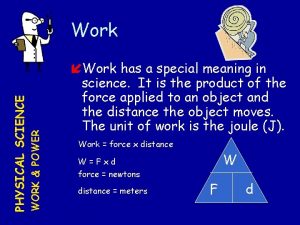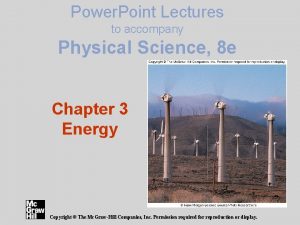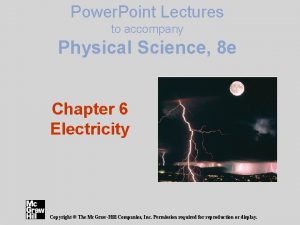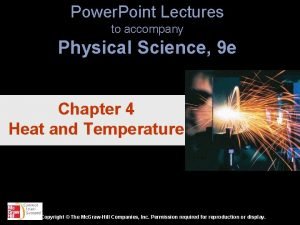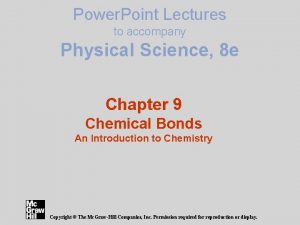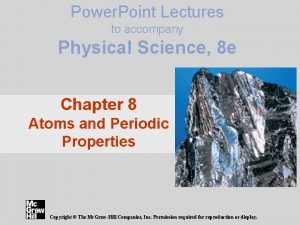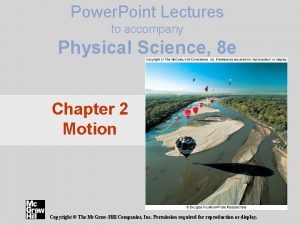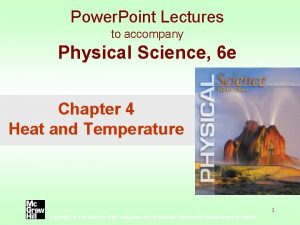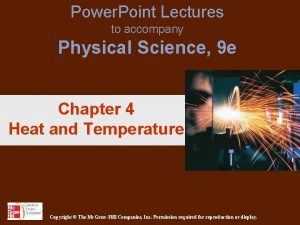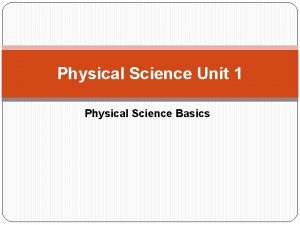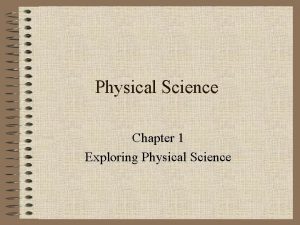Power Point Lectures to accompany Physical Science 8
































- Slides: 32

Power. Point Lectures to accompany Physical Science, 8 e Chapter 4 Heat and Temperature Copyright © The Mc. Graw-Hill Companies, Inc. Permission required for reproduction or display.

Core Concepts A relationship exists between heat, temperature, and the motion and position of molecules.

Overview Thermodynamics Approach here • Study of macroscopic processes involving heat, mechanical and other forms of energy • Applications - systems with energy inputs and outputs: heat engines, heat pumps, refrigerators, … • Based upon but not concerned with microscopic details • Discuss underlying microscopic processes • Relate microscopic and macroscopic views • Study the laws of thermodynamics

Kinetic Molecular Theory • Collective hypotheses about the particulate nature of matter and the surrounding space • Greeks - earliest written ideas on atoms • Current view – Matter comprised of microscopic particles - atoms – Atoms combine to form molecules – Many macroscopic phenomena can be traced to interactions on this level.

Molecules • Chemical elements defined by each unique type of atom • Compounds - pure substances made up of two or more atoms chemically bonded • Molecules – Smallest unit retaining the properties of a compound – Shorthand here: “molecules” can stand for either atoms (monatomic molecules) or molecules Molecular interactions • • Usually attractive, causing materials to cling together Cohesion - attractive forces between like molecules Adhesion – Attractive forces between unlike molecules – Water wetting skin – Glue mechanism; adhesives Interactions can also be repulsive – Water beading on wax

Phases of Matter - Solids • Definite shape and volume • Rigid 3 -D structure • Atoms/molecules bonded in place • Allowed motions restricted to vibration in place only

Phases of Matter - Liquids • Definite volume, indefinite shape • Only weak cohesive bonds between component molecules • Constituent molecules mostly in contact • Allowed motions – Vibration – Rotation – Limited translation

Phases of Matter - Gases • Indefinite volume and shape • Molecules mostly not in contact • Allowed motions – Vibration and rotation (molecules with more than one atom) – Translation on random, mostly free paths

Molecular Motions • Characterized by average kinetic energy in a large sample • Temperature – Measure of average kinetic energy on the molecules making up a substance – Proportional to average KE • Evidence – Gases diffuse quicker at higher temperatures – Expansion/contraction with increasing/decreasing temperature

Temperature • A measure of the internal energy of an object • Thermometers – Used to measure temperature – Rely on thermometric properties – Example: bimetallic strips and thermostats

Temperature Scales • Defined w. r. t various reference points • Fahrenheit • Celsius • Kelvin

Temperature Scales • Conversion formulas – Fahrenheit to Celsius – Celsius to Fahrenheit – Celsius to Kelvin

Heat • A form of energy transfer between two objects • External energy - total potential and kinetic energy of an everyday-sized object • Internal energy - total kinetic energy of the molecules in that object • External can be transferred to internal, resulting in a temperature increase

Heat versus Temperature • A measure of hotness or coldness of an object • Based on average molecular kinetic energy Heat • Based on total internal energy of molecules • Doubling amount at same temperature doubles heat

Heat Definition Heating methods • A measure of the internal energy that has been absorbed or transferred from another object • Two related processes 1. – “Heating” = increasing internal energy – “Cooling” = decreasing internal energy 2. Temperature difference: Energy always moves from higher temperature regions to lower temperature regions Energy-form conversion: Transfer of heat by doing work

Measures of Heat Metric units English system • calorie (cal) - energy needed to raise temperature of 1 g of water 1 degree Celsius • kilocalorie (kcal, Calorie, Cal) - energy needed to raise temperature of 1 kg of water 1 degree Celsius • British thermal unit (BTU) - energy needed to raise the temperature of 1 lb of water 1 degree Fahrenheit Mechanical equivalence • 4. 184 J = 1 cal

Specific Heat Variables involved in heating • Temperature change • Mass • Type of material – Different materials require different amounts of heat to produce the same temperature change – Measure = specific heat Summarized in one equation

Heat Flow Three mechanisms for heat transfer due to a temperature difference 1. 2. 3. Conduction Convection Radiation Natural flow is always from higher temperature regions to cooler ones

Conduction • Heat flowing through matter • Mechanism – Hotter atoms collide with cooler ones, transferring some of their energy – Direct physical contact required; cannot occur in a vacuum • Poor conductors = insulators (Styrofoam, wool, air…)

Sample Conductivities Material Relative conductivity Silver 0. 97 Iron 0. 11 Water 1. 3 x 10 -3 Styrofoam 1. 0 x 10 -4 Air 6. 0 x 10 -5 Vacuum 0

Convection • Energy transfer through the bulk motion of hot material • Examples – Space heater – Gas furnace (forced) • Natural convection mechanism - “hot air rises”

Radiation • Radiant energy - energy associated with electromagnetic waves • Can operate through a vacuum • All objects emit and absorb radiation • Temperature determines – Emission rate – Intensity of emitted light – Type of radiation given off • Temperature determined by balance between rates of emission and absorption – Example: Global warming

Energy, Heat, and Molecular Theory Two responses of matter to heat 1. Temperature increase within a given phase – – Heat goes mostly into internal kinetic energy Specific heat

Energy, Heat, and Molecular Theory Two responses of matter to heat 2. Phase change at constant temperature – – Related to changes in internal potential energy Latent heat

Phase Changes Solid/liquid Liquid/gas Solid/gas Fusion Vaporization Sublimation Temperature Melting point Boiling point (Direction ->) Sublimation Latent heat Temperature Freezing point Condensation Sublimation point (Direction <-)

Evaporation and Condensation • Individual molecules can change phase any time • Evaporation: – Energy required to overcome phase cohesion – Higher energy molecules near the surface can then escape • Condensation: – Gas molecules near the surface lose KE to liquid molecules and merge

Thermodynamics • The study of heat and its relationship to mechanical and other forms of energy • Thermodynamic analysis includes – System – Surroundings (everything else) – Internal energy (the total internal potential and kinetic energy of the object in question) • Energy conversion – Friction - converts mechanical energy into heat – Heat engines - devices converting heat into mechanical energy – Other applications: heat pumps, refrigerators, organisms, hurricanes, stars, black holes … virtually any system with energy inputs and outputs

The First Law of Thermodynamics • Conservation of energy • Components – Internal energy – Heat – Work • Stated in terms of changes in internal energy • Application: heat engines

The Second Law of Thermodynamics Equivalent statements: Two reference scales: • 1. • • No process can solely convert a quantity of heat to work (heat engines) Heat never flows spontaneously from a cold object to a hot object (refrigerators) Natural processes tend toward a greater state of disorder (entropy) An object’s external energy – – 2. Energy of global, coherent motion Associated with work An object’s internal energy – – Energy of microscopic, chaotic, incoherent motion Associated with heat

Second Law, First Statement Conservation of energy, heat engine • Input energy = output energy Efficiency of a heat engine • Work done per unit input energy Second law: • Efficiency cannot equal 1 • Some energy always degraded

Second Law, Second Statement Conservation of energy, heat pump • Energy arriving in high temperature region = energy from low temperature region + work needed to move it • Upgrading of energy by heat pump accompanied by greater degradation of energy elsewhere

Second Law, Third Statement • Real process = irreversible process • Measure of disorder = entropy Second law, in these terms: • The total entropy of the Universe continually increases • Natural processes degrade coherent, useful energy – Available energy of the Universe diminishing – Eventually: “heat death” of the Universe • Direction of natural processes – Toward more disorder – Spilled milk will never “unspill” back into the glass!
 Things that belong to salvation
Things that belong to salvation Accompany chapter 1
Accompany chapter 1 Cephalic vein in hand
Cephalic vein in hand Inkjet printers are considered legacy technology
Inkjet printers are considered legacy technology Power system lectures
Power system lectures Power physical science
Power physical science Active power reactive power apparent power
Active power reactive power apparent power Branches of science mind map
Branches of science mind map Natural and physical science
Natural and physical science Informsu
Informsu My favorite subject is music
My favorite subject is music Point point power
Point point power Rick trebino
Rick trebino Lectures paediatrics
Lectures paediatrics Data mining lectures
Data mining lectures Medicinal chemistry lectures
Medicinal chemistry lectures Uva presentation template
Uva presentation template Ludic space
Ludic space Activity based approach in software project management
Activity based approach in software project management Molecular biology lecture
Molecular biology lecture Radio astronomy lectures
Radio astronomy lectures Dr sohail lectures
Dr sohail lectures Utilities and energy lectures
Utilities and energy lectures Web engineering lectures ppt
Web engineering lectures ppt Do words have power
Do words have power Frcr physics lectures
Frcr physics lectures Rotating anode
Rotating anode Introduction to recursion
Introduction to recursion Guyton physiology lectures
Guyton physiology lectures Define aerodynamics
Define aerodynamics Tamara berg husband
Tamara berg husband Theory and practice of translation lectures
Theory and practice of translation lectures Translation 1
Translation 1





